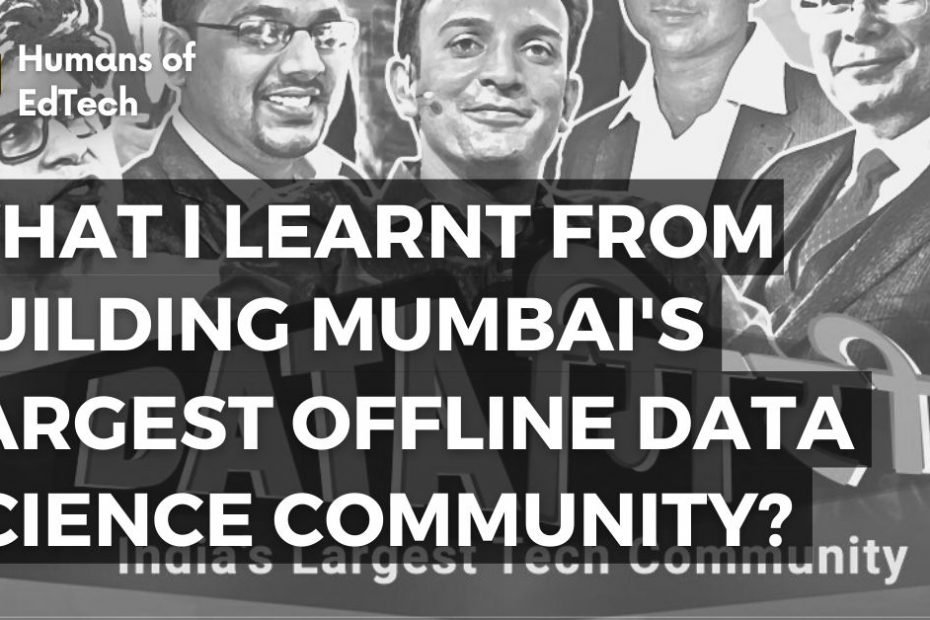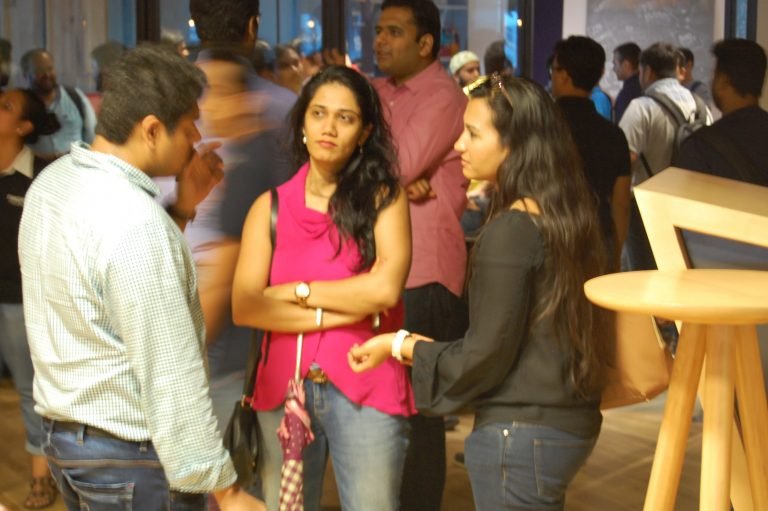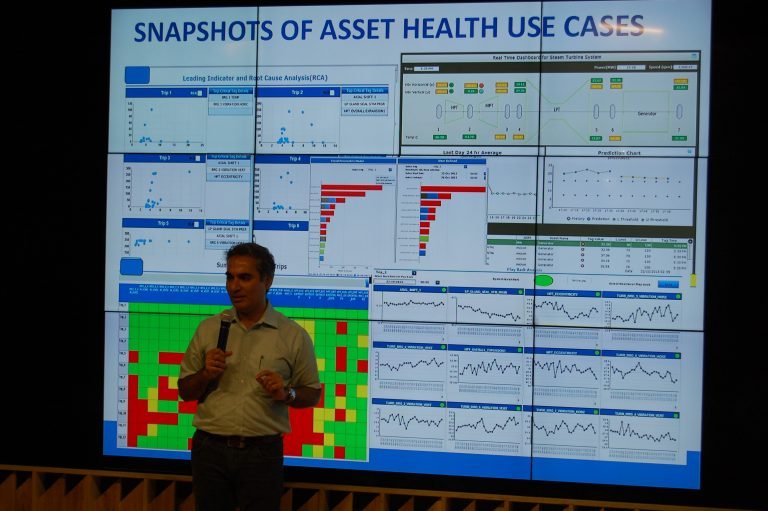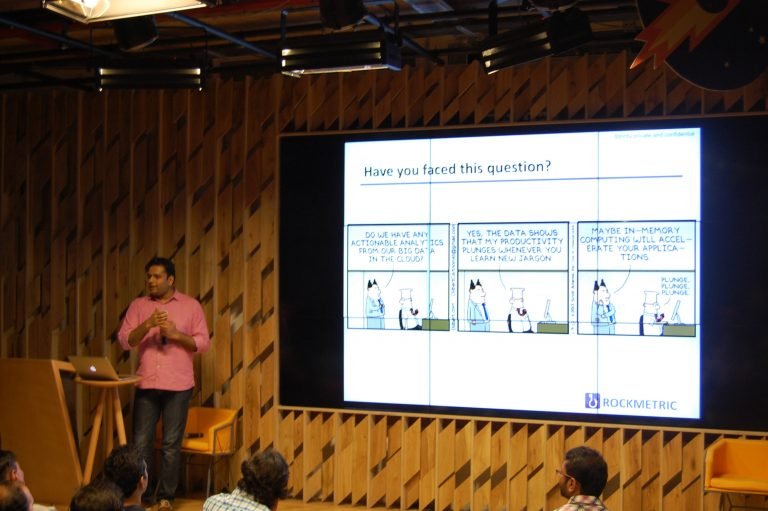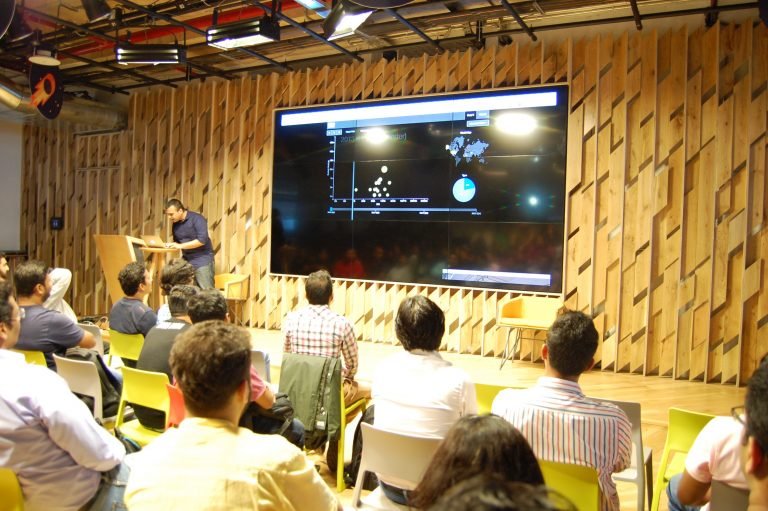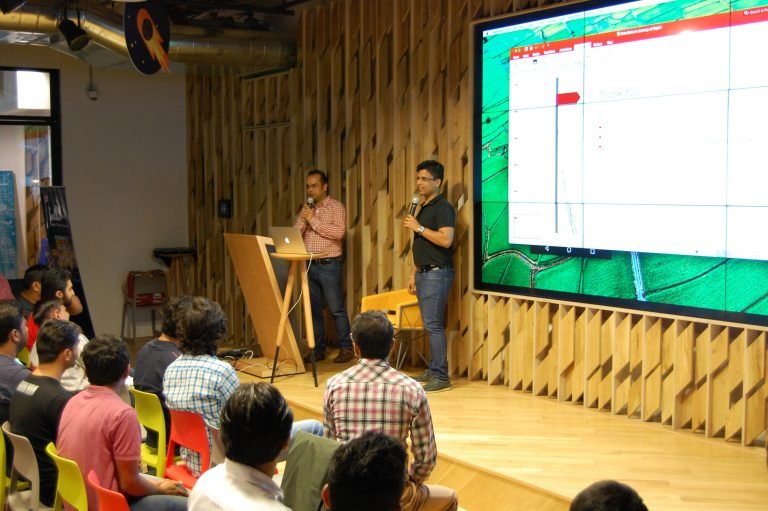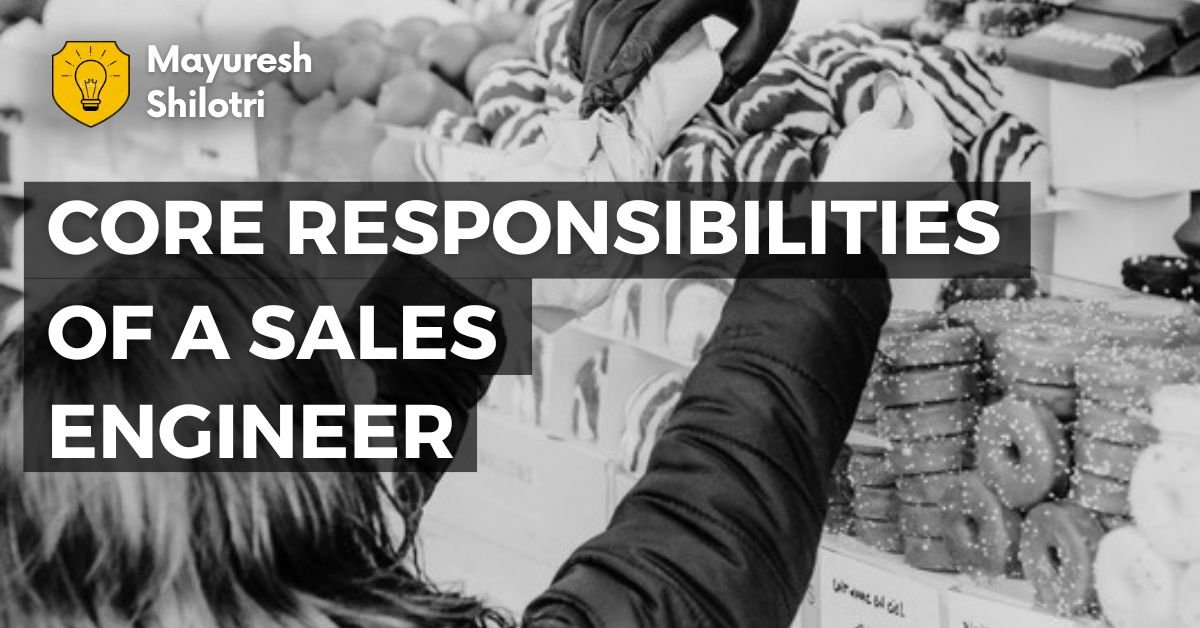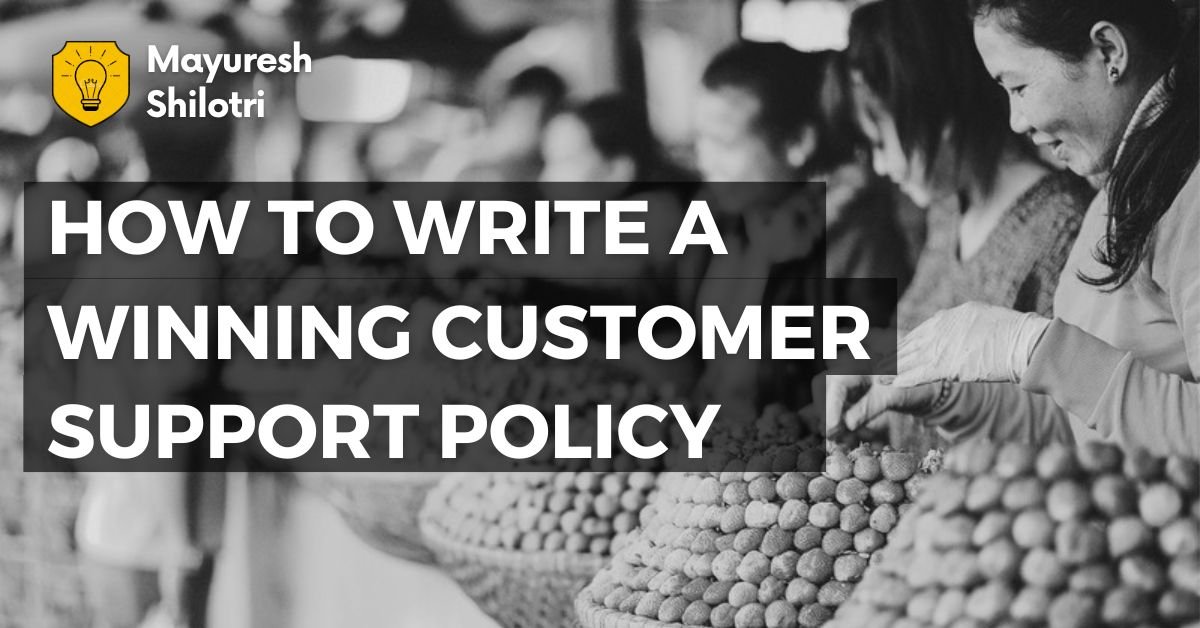Community building requires certain ascetic quality. Communities are a sure shot way of building brands and longevity. The reason why a lot of brands don’t do it – It’s hard. Requires uncommon passion. Takes time.
DataGiri at the time of writing this blog post is the largest tech community in Mumbai. This can mean multiple things. The reason why we started it is – it gives hope to people, its clean, its to add value to the participants, we truly unlock something magical.
Something like this can only be built out of passion and not reason.
- Words:4191 (Skim friendly)
- Type: Post
- Video:0
- Slides: 0
- Topic: Humans Of EdTech
- TIME: 6 Minute
Why we started DataGiri?
Today in this session, we are going to look at what, how did we build one of the largest data science communities in Mumbai. Great. So the journey for us regarding building DataGiri was very purpose driven. We essentially were building a product called 9Content, which was a MarTech product.
This was a content recommendation and measurement engine that we had proposed based on our experience in Customer360. Now, to build out some of these products, we essentially were looking to onboard some data scientists who had done work in the natural language processing (NLP) space. Now, when we actually went to the LinkedIn profiles of people, tried to speak to them, reach out to them, we essentially found out that people were putting a lot of certificates which were short courses in R or SAS.
People had done seven day courses and 30 day courses. But essentially an end to end practitioner who could develop web scale applications and also had a firm grounding in data sciences and ability to understand businesses.
That still is rare, but at that point in time, it was almost non-existent,
First Community Event

So what we figured out is that we need to reach out to some of these people not with like job postings or directory scouting for people directly. But more by creating a community. So we essentially started with the meetup community to solve for our own problem. And our problem was to meet and reach out to some of these people. So when we created the first event, in the first event, we put together a venue; the venue was very swanky looking place in downtown Mumbai, called as Rise Mumbai, which is built in collaboration with Barclays. And we had like a footfall of close to 125 people. We had, like, really someone who was a senior person in the data sciences domain from Infosys kick-start the session for us. Plus, I think we had some very interesting lineup of speakers back then. So that’s how the whole thing started.
125 people in one particular room, which is not a classroom setup, nothing concrete was promised regarding what is the expectation and outcome from today’s session, we’re just going to do some geeky nerd stuff. In a very unstructured format, attendees were getting a lot from that community, they could take a lot of things from the community regarding learning, engagement & contacts. Community connects people who are on the industry side; they came to that forum, and they could find people, talent, networking opportunities, job seekers. who reach out to the industry, professionals and partner.
So it is a very vibrant kind of setup. And we really didn’t completely, at that point in time understand the magnitude of what was happening. But yeah, that’s how it goes. That’s how the whole data meetup community in Mumbai got started.
Vision for Community
Let me just quickly share that with you. we had a very clear vision regarding wanting to connect the aspirants with the industry, within the academia, and everyone, all the stakeholders, we can bring them together. The modus operandi as we envisioned it, in the beginning, was very much around curating events by facilitating live contacts, by live interaction between the people. It was a very clear long-term vision for DataGiri.
Community can be a great top of the funnel for you. I think the thing to be aware over here is that if you treat a community as the top of the funnel, then people in the community are going to figure it out sooner than later. And then it is going to be classified as one of those places where there is no value that is getting offered. And the word will spread, and it’s going to sincerely not work out for you. But it is not does not mean that it doesn’t work, I think, you know, it can be made to work.
Second, community can also give some early feedback for your product. So it can be very inexpensive ways to recruit a lot of people and give you some valuable feedback on that.
How to build a community?
Number one thing that you do is – you essentially conduct events with certain sense of regularity, there is a frequency – that there is a monthly meetup or there is a fortnightly meetup, or there is a meetup every two months, a monthly meetup is best suited, because you’re always able to promote a meetup while you’re conducting a particular meetup. So I think a monthly meetup is one of the best things you can do when you’re beginning with it.
Second, whenever you’re curating event, there has to be a specific theme around it. And strongly signal out what kind of, you know, participants you’re looking out for, and what is the topic and why be attending. That is something that has to be strongly clearly done. So if you’re doing event with all the business heads in data sciences, you know, have a top level business discussion regarding impact of data sciences or something that is futuristic. So that is something very important. Or it can be a complete geek and nerd event where you’re actually showcasing how to install a particular library, deploy something, or actually build a small chatbot. Something that is a very Do-It-Yourself kind of session where you expect people to come with laptops. So it really depends on what is this event all about. So having a powerful theme around the events is very important.
Next, Meetup.com has a feature where you have attendee reviews. you know, the students that the people who essentially attend the meetups can give in their reviews. Reviews that are written on individual events, or your meetup community. Initially, you may need to encourage people to write something on your meetup or their experience, and you genuinely want feedback. And you also want people to share that feedback on the right forum.
Third, there is that participant count that always comes along with the event. One of the easiest ways to get the participation going is that you invite your near and dear ones, your people in the same circle, you promote the event aggressively and get people to RSVP. Ask them to do RSVP + 5 Guests. Suddenly, you see that 100+ people who are interested, then a lot more people automatically get attracted to it. So showing that initial traction is very, very important. And once you show the initial traction, then many people automatically get gravitated towards it, and then they kind of come.
Fourth, you may have your existing databases, WhatsApp groups, SMS list, you need to reach out to those people and create awareness about this across different channels.
Fifth, do co-branded events, with different meetups.
Sixth, event quality is very much linked to the quality of the speakers. Now, having the right speakers selecting the right speakers, and bringing out events particularly, I think it’s a full-time role. The quality is something that you have to ensure because it’s I think people come for the event and they don’t find value, or they find something that is totally gibberish, I think what is going to happen is that people are going to point fingers towards the community that is essentially organising it. So the quality control is something that you own as the community Community Manager. Now, there are multiple ways if you’re doing some sort of technical session, then you definitely need to have, you know, do the credential check of the person regarding what kind of GitHub repository do they have? What kind of GitHub repository do those people have, what kind of work they have done, you might actually want to have some sort of mini quick, almost sanity check regarding whether the person really knows his or her stuff. Have a human conversation.
Seventh, you definitely need to check the communication skills of the person. Because all said and done, the person may not be like very articulate or fluent, but the person has to stand in front of the audience which can be anywhere between 50 to 200 people strong, and then be able to communicate, and can make it interesting. Cold feet – the person just refuses to show up on the last day because the cold feet, of course, people will call it out that they have had upset stomach, or they have had a bout of fewer. But the fact of the matter is that people develop cold feet, and it happens. It’s not something that is uncommon.
Eighth, have a dry run. And dry run is very, very important. What happens over there is even if the session is not a technical session, it’s a session which is more on the business side, or write on essentially help you establish the narrative. In the meetup event, there are multiple things that come together the speaker has to introduce before that the sponsors have to come in, there has to be a Q&A, there has to be a logical break, there has to be the whole content matter that is separate, there is a post activity, then there is a session for networking. So these elements need to be orchestrated. So a dry-run definitely helps. And dry-run can be done online. But for a particular speaker, if there are multiple speakers that are scheduled for a day, and who goes in first is very, very important. And how will you typically slot the Q&A sessions, whether they are separate Q&A sessions, or there are single Q&A sessions where all the people go on stage and everything. So all of those things matter.
Last, having people on the same premise in a venue where people want to showcase something that is proprietary or which is only on their laptop, if especially if it is a developer laptop, then you will need to be switching the laptops frequently. Now it is a switching between Mac and a Windows, even if it is an Mac and PC connector. So there are multiple possibilities & dynamics that create problem.
Challenges in running a Community
Despite all the fantastic planning, sometimes things don’t go your way. You have sessions where the speaker doesn’t show up or the speaker shows up one and a half hours late. And it happens, and it has happened with us. How do you handle and manage such sessions? So I think there is always you need to know when this is a lesson that we learned the hard way.
So we used to do solo speaker events. But that was after that event, we never did a solo speaker event. We always have multiple speakers for an event. So just in case anyone backs out you Always have multiple people who can come in and the sessions, people have developed cold feet regarding, you know, their interest, or they get scared or they get stage fright and all those kinds of things and people don’t come up.
There is an exceptionally low turnout. So if you’re doing a co-branded event, and you’re promised that, you know, people want it, people are going to show up, and 20 people show up, that’s like a major problem. Because especially if they have invested in snacks, food and beverages, and these things definitely create a lot of problems, especially regarding your ability to put together an event coherently. And sometimes it may not be attributed to you but factors like the monsoon. Or if it is something like a North Indian summer, you really cannot guarantee any kind of participation. So you really have to jack up the numbers and get people going.
And last thing over here is sponsor hijacking. What we mean by sponsor hijacking – we allocate Sponsor 5-minute slot, but the sponsor essentially goes overboard and just, you know, keeps on rambling for 25 minutes. Okay, this has happened to us. We are just, you know, calling it out. And it happens. So that’s like the problem.
The next is co-branded when you restrictions. So typically, when you’re doing an event with a brand and it was being conducted in their premises, then many things come in. Well, you know, you need to have to get passes that need to be issued for every participant; the participant names need to be submitted upfront, no audio-visual equipment is allowed over there. Certain sites are banned, as per the firewall policy of the company. So many things essentially go wrong. Even in the dry run, some of these things don’t get caught. We need to have a very, very strong checklist over here.
People Process and Tooling
You need a mailing software where essentially you can reach out to masses of people. And the email IDs that come into this mailing software are as part of the opt-in process that comes from different sources. You also need to have SMS in capabilities. Because the attendance in a webinar, the attendance and for an offline event are driven by how strongly you can remind them closest to the event. We put in an offline event. If you’re able to send them reminders or two hours ahead of time, you will have a lot of participation. Similarly, having the right WhatsApp groups and Telegram groups definitely help in making sure that people come for your events.
You always need a software something like Canva, where you’re able to put together creatives in a very agile way to help drive the participation.
Regarding the processes, we already looked at the standard operating procedures, protocols that need to be in-place, the checks and balances that need to be in place, we discussed all of them briefly.
This is a full-time role within our organisation. At an executive level, this is not a full-time role, an executive can dedicate a certain percentage of his or her capacity to make it a possibility. But regarding the operations part, this is a full-time role a person has to be constantly be talking to speakers, venue partners, curating events, and it is a complete full-time kind of thing. So that’s essentially the future of community. So I think the future of community is already here. A lot of what we are discussing over here is 2016, and 2017 kind of stuff.
The future of community is already here. I think you’re seeing a lot of vertical communities (ClubHouse), groups, community of one community of specialised people, specific products getting built for it. Mobile centric communities, communities, which are based on time specific interest, seasons, specific interest, meetup has reinvented itself as a tool as a product. Future of community is very robust. Community as medium, as a channel, as a way of doing business is going to be there. It was always there. Pandemic has thrust this whole thing forward as a global community, where you don’t need to be geographically co-located, to be doing some of these things.
Photo by Matheus Bertelli from Pexels
Join to get sneak peek into what's happening
I write about books, experiences, product, UX, EdTech, early stage growth, validation – mostly tech. Subscribe if these topics interest you. Once every 15 days emailer. I promise – No spam. (I am known for it otherwise) 😉
